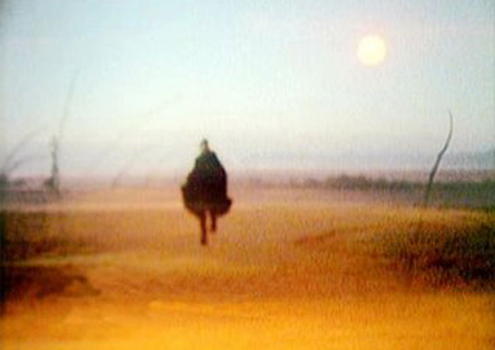A Warning to the Curious in Aldeburgh, Suffolk: East Anglia’s ghost trail
Seaburgh’s warning to the curious
If, like me, you’re a fan of the good old English ghost story, then you’ve probably read at least one by M R James. My favourite, I must confess, is ‘A Warning to the Curious’, but this is due largely to the iconic BBC adaptation of the short story which was made in 1972. Directed by Lawrence Gordon Clark, and starring Peter Vaughan and Clive Swift, with a memorable performance by John Kearney, this classic little chiller can still send a shudder up many a spine today. Being frightened out of my wits by this film as a child is what started my interest in the story and, undoubtedly but thankfully, led me to the many ‘anxious’ hours I have subsequently spent in the deliciously dark company of England’s master of the traditional ghost story, Montague Rhodes James.
Tracking down the locations in the story can be a tricky business and, if you’re trying to do it in one trip, it’s probably best to choose either the film or the text, as one will point you to Norfolk and the other to Suffolk.
So let’s deal with the original source material first. James’s chilling little number is set in the fictional seaside town of Seaburgh, which is simply sited as being ‘on the east coast’. In a prologue to his ‘Collected Ghost Stories’ the author states clearly that his inspiration for Seaburgh was the sleepy little resort of Aldeburgh, nestling quaintly but quietly on the Suffolk coast. Although born in Goodnestone Parsonage in Kent in 1862, James had a lifelong affinity with the seaside town, visiting it often for holidays. He describes it thus:
The place on the east coast which the reader is asked to consider is Seaburgh. It is not very different now from what I remember it to have been when I was a child. Marshes intersected by dykes to the south, recalling the early chapters of Great Expectations; flat fields to the north, merging into heath; heath, fir woods, and, above all, gorse, inland. A long sea-front and a street: behind that a spacious church of flint, with a broad, solid western tower and a peal of six bells. How well I remember their sound on a hot Sunday in August, as our party went slowly up the white, dusty slope of road towards them, for the church stands at the top of a short, steep incline. They rang with a flat clacking sort of sound on those hot days, but when the air was softer they were mellower too. The railway ran down to its little terminus farther along the same road. There was a gay white windmill just before you came to the station, and another down near the shingle at the south end of the town, and yet others on higher ground to the north. There were cottages of bright red brick with slate roofs… but why do I encumber you with these commonplace details? The fact is that they come crowding to the point of the pencil when it begins to write of Seaburgh. I should like to be sure that I had allowed the right ones to get on to the paper. But I forgot. I have not quite done with the word-painting business yet.
Walk away from the sea and the town, pass the station, and turn up the road on the right. It is a sandy road, parallel with the railway, and if you follow it, it climbs to somewhat higher ground. On your left (you are now going northward) is heath, on your right (the side towards the sea) is a belt of old firs, wind-beaten, thick at the top, with the slope that old seaside trees have; seen on the skyline from the train they would tell you in an instant, if you did not know it, that you were approaching a windy coast. Well, at the top of my little hill, a line of these firs strikes out and runs towards the sea, for there is a ridge that goes that way; and the ridge ends in a rather well-defined mound commanding the level fields of rough grass, and a little knot of fir trees crowns it. And here you may sit on a hot spring day, very well content to look at blue sea, white windmills, red cottages, bright green grass, church tower, and distant martello tower on the south.
Once James as narrator has evoked the setting of the story, he allows his friend to take over, who goes on to tell us of a stay in an inn called ‘The Bear’ at Seaburgh, where he came across a very nervous-seeming young man who was afraid to be alone. This young man, Paxton by name, then tells his story of having learned from the local rector of a legend of three Anglian crowns buried along the coast as protection from foreign invaders. One crown, according to the legend, had been discovered and melted down, and the second had been washed into the sea by coastal erosion. The third crown, the last remaining defence, was still buried along the coast but protected through generations by the men of the Ager family. When Paxton discovers that the last of the Agers has just died, his curiosity is piqued. When he ascertains from another local the possible location of the buried crown, he is compelled to unearth it. Having done so, however, he finds himself constantly followed by a mysterious presence. He is desperate to put the crown back where he found it, but it may be too late. It is for this task he enlists the help of the other two main protagonists of the tale.
Apart from the total loss of the old battery and settlement of Slaughden to the ravaging sea, Aldeburgh is pretty much today as the author described it. Many of the landmarks featured in the story can easily be tracked down, and the footsteps of the characters can be followed with little difficulty. A good base is The White Lion, a Best Western hotel which, although now considerably altered and devoid of ‘sitting rooms’, was actually ‘The Bear’ in James’s narrative. If you’re looking for more modest accommodation and don’t want to pay almost a fiver for the smallest glass of red, you could try the excellent ‘Toll House’ situated on Victoria Road, just off the main roundabout as you enter Aldeburgh. You’ll find no bar here (although the lively and convivial ‘Railway’ pub is literally just across the way) and you certainly won’t have a sea view, but this clean and friendly establishment is well run by Richard and Isobel, and is no more than five minutes walk from the town centre. And they do serve up a mean full English, packed with delicious local produce cooked to perfection; just the ticket to set you up for a day’s ghost hunting.
The short walk to the beach will take you past the Parish Church of St Peter and St Paul. Although only featured briefly in the story itself as young Paxton, accompanied by the narrator and his friend, Henry Long, attempts to return the crown, it’s worth a brief sojourn here to visit the graves of Suffolk composer Benjamin Britten and his lover Peter Pears. Much is made of Britten’s connection with Aldeburgh, which by contrast seems to highlight the fact that absolutely nothing can be found relating to M R James or ‘A Warning to the Curious’. Even the ‘literary expert’ to whom we were pointed at one of the town’s main book shops, could only manage a cursory, dismissive grunt as she thrust a copy of Wilkie Collins’ ‘No Name’ at us without really listening to our question. “M R Who..?” she barked eventually, “No. There’s nothing,” and then, without further ado, promptly turned her back on us to strike fear into the heart of the next customer patiently waiting for her contentious wisdom.
Also worth examining at the Peter and Paul Church is the stunning Britten window by John Piper, before meandering your way through the graveyard to the claustrophobic ‘narrow path with close, high hedges’ – the route taken by the three men on their way to return the misappropriated treasure.
These secluded paths lead down to the beach itself, which is exactly as described:
There was a choice of ways: past the houses on the sea-front, or along the sand at the bottom of the beach, which, the tide being now out, was fairly broad. Or of course we might keep along the shingle between these two tracks and have some view of both of them; only that was heavy going. We chose the sand, for that was the loneliest, and someone might come to harm there without being seen from the public path.
From the sea front, you can walk southwards towards, first, the only remaining windmill of the several James describes, now sadly without sails, and second the martello tower. The latter now belongs to the Landmark Trust and is probably in far better condition than it ever was. At the north end of the beach lies the timber framed Moot Hall, which has the dual function of museum and town hall, and has one or two interesting exhibits to complete the story well worth the modest one pound entrance fee. An 1860s print clearly shows the old gun battery just north of the martello tower intact. The second half of the nineteenth century must have seen a great deal of damage; by the turn of the century the battery was a crumbling ruin. This whole coast has suffered from the inroads of the sea. In the sixteenth century there were three whole streets to seaward of the current front, and the Moot Hall itself, now practically on the beach, was well inland. You’ll also find a picture painted around 1900 depicting the railway (which fell victim to Dr Beeching in the sixties), the ridge of firs where the crown was supposedly buried, and, in the far distance, the north sea. The trees were much more sparse then, but the picture gives you a good idea of the scene as it was in the story.
The church at Froston, whose porch houses the coat of arms depicting the ‘three Anglian crowns’ which initially fuel Paxton’s interest in his folly, is not so easy to place. It could be at nearby Friston, where there is indeed a church, but the absence of both the heraldic clue over its porch or any other intelligence bequeathed by James himself, leaves this open to some conjecture.
Now, as I’ve already intimated, this is all very well if you’re following James’s actual text. However, if you are a devotee of the film and not the literature, you will have come completely unstuck as soon as you set foot in Aldeburgh. Trying to uncover the actual locations for filming can frequently be frustrating, as what meagre sources of information there are can be at best sketchy and at worst conflicting. What’s absolutely clear is that no filming was done either in or around Aldeburgh or, indeed, anywhere in Suffolk.
To follow the location of Clark’s masterpiece, you’ll have to migrate to Norfolk, to the even sleepier Wells-next-the-Sea on the north coast. A modest trip eastwards will have you fetch up at Happisburgh, where you’ll definitely locate the church featured in the film, together with the red and white stripy lighthouse to which Vaughan’s older Paxton cycles.
Popularity: 4% [?]
You can leave a response, or trackback from your own site.

Got something to say..? Leave your thoughts...
6 Responses to “A Warning to the Curious in Aldeburgh, Suffolk: East Anglia’s ghost trail”









Je suis un grand admirateur de M.R.JAMES, je le traduit en français car peu de ses nouvelles ont été publiées dans notre pays.
Salutations
Most interesting article, as I was also as a child frightened by this memorable BBC xmas ghost story and by accident found that my favourite annual holiday destination of Wells -next -the- Sea in Norfolk to be the setting for much of the film, but have for some 25 years wondered and looked out for the three crowns church, for which I now know it’s location.
Hi Dean – St Mary’s Church in Happisburgh is indeed the church used in the film, as you’ll see from the images if you click through on the ‘Happisburgh’ link in the above article. But don’t be too disappointed at not finding the three crowns on the stonework above the door – these were simply ‘stuck on’ for the benefit of the film.
[...] lies with James painting an almost perfect geographical picture of Aldeburgh (the World Travel Blog confirms this). Definitely a story that’s perfect for those who like to explore literary places in the [...]
Interesting piece. Took me years and some happy coincidences to fully unravel the various locations of both story and films (I still get ‘Whistle and I’ll Come To You’ muddled with ‘Curious’ too). I don’t think it’s too surprising that Britten is far more celebrated than James for his Aldeburgh connection. I’m not sure James actually lived there, did he? And the Britten legacy (Snape etc) is still – perhaps more so – quite vigorous today.
very interesting, wish I’d read this before travelling to Aldeburgh!! did notice the petrol station on the way in to Aldeburgh had the George cross with a crown in the middle flying from flag poles.. east Anglia crowns connection?